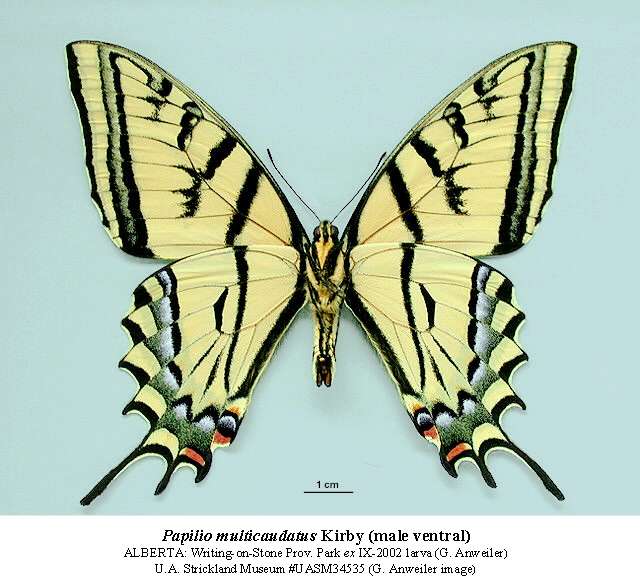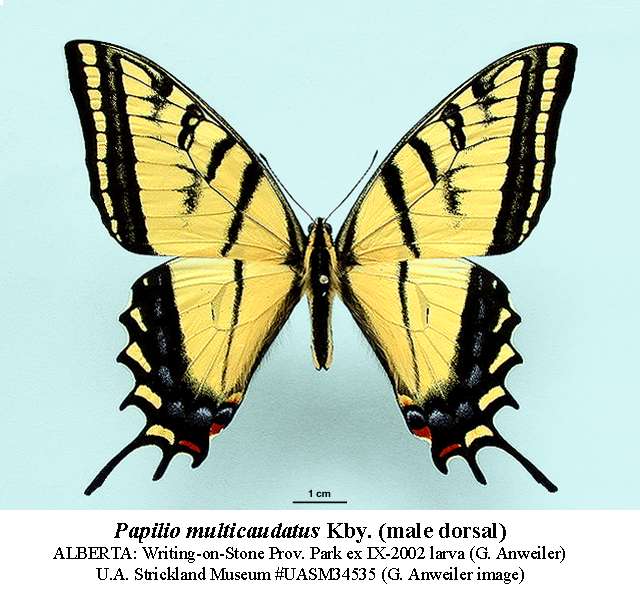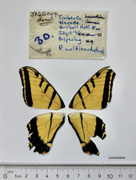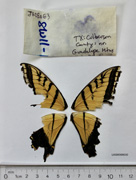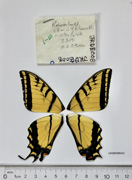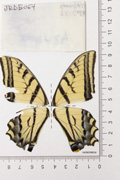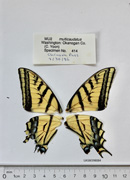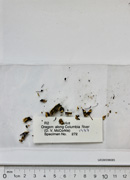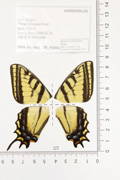« Back to UASM398029
Species Details
Papilio multicaudatus
University of Alberta E.H. Strickland Entomological Museum Read more about this collection »
Common NameTwo-tailed Swallowtail
SeasonalityAdults fly from June to September; peaking in late June (Bird et al., 1995).
IdentificationAdults are very large (90-127 mm wingspan). They are easy to distinguish from other swallowtails in Alberta by their size and because each hindwing has two tails, one twice as long as the other. The most similar species in Alberta is the Canadian Tiger Swallowtail (P. canadensis), which is smaller, has wider black bands and lacks the additional tail.
Larvae are apple green and have two eye-spots near their head. They have a yellow green to yellow main eyespot with a pale blue centre, it is surrounded by a black line. The adjacent satellite spot is also yellow green to yellow and is enclosed by a black line. There is a yellow anterior band that is narrower than the black transverse band (Guppy & Shepard, 2001). A few days before pupating, the larvae turn red-brown.
Pupae are mottled green brown to yellow brown, with a brown lateral stripe (Guppy & Shepard, 2001).
Scientific Name
Papilio multicaudatus
Common Name
Two-tailed Swallowtail
Habitat
In Alberta, found in coulees and riparian areas in the southern grasslands.
Seasonality
Adults fly from June to September; peaking in late June (Bird et al., 1995).
Identification
Adults are very large (90-127 mm wingspan). They are easy to distinguish from other swallowtails in Alberta by their size and because each hindwing has two tails, one twice as long as the other. The most similar…
Adults are very large (90-127 mm wingspan). They are easy to distinguish from other swallowtails in Alberta by their size and because each hindwing has two tails, one twice as long as the other. The most similar species in Alberta is the Canadian Tiger Swallowtail (P. canadensis), which is smaller, has wider black bands and lacks the additional tail.
Larvae are apple green and have two eye-spots near their head. They have a yellow green to yellow main eyespot with a pale blue centre, it is surrounded by a black line. The adjacent satellite spot is also yellow green to yellow and is enclosed by a black line. There is a yellow anterior band that is narrower than the black transverse band (Guppy & Shepard, 2001). A few days before pupating, the larvae turn red-brown.
Pupae are mottled green brown to yellow brown, with a brown lateral stripe (Guppy & Shepard, 2001).
Life History
Adults are known to mud-puddle. Males patrol stream courses, lake margins, forest edges and openings, and city streets looking for receptive females [Opler et al., 1995]). Females lay eggs singly on leaves of host…
Adults are known to mud-puddle. Males patrol stream courses, lake margins, forest edges and openings, and city streets looking for receptive females [Opler et al., 1995]). Females lay eggs singly on leaves of host plant (Guppy & Shepard, 2001). Larvae hatch, consume the egg chorion, eat leaves and rest on silken mats in shelters of curled leaves (Opler et al., 1995; Guppy & Shepard, 2001). Eggs are pale green yellow (Guppy & Shepard, 2001). They are univoltine and the pupae overwinter (Opler et al., 1995; Guppy & Shepard, 2001; Anweiler, pers. obs.).
Conservation
Rare; provincial rank S1 and "Status Undetermined" because of few records.
Diet Info
Unknown for Alberta. Elsewhere, cherries (Prunus spp.), ashes (Fraxinus spp.), hop tree (Ptelea trifoliata), chokecherry (Prunus virginiana) and Saskatoon (Amelanchier alnifolia). Adults feed on flower nectar and in…
Unknown for Alberta. Elsewhere, cherries (Prunus spp.), ashes (Fraxinus spp.), hop tree (Ptelea trifoliata), chokecherry (Prunus virginiana) and Saskatoon (Amelanchier alnifolia). Adults feed on flower nectar and in Alberta they have been observed feeding on thistles (Carduus spp. and Cirsium spp.) and Wild Bergamot (Monarda fistulosa) (Lancaster, 1988; Sperling & Kondla, 1991; Bird et al., 1995).
Range
Other Canadian records are from southern British Columbia and southwestern Saskatchewan (Layberry et al., 1998). It has a wide range in the western United States, south through Mexico and Central America to Ecuador,…
Other Canadian records are from southern British Columbia and southwestern Saskatchewan (Layberry et al., 1998). It has a wide range in the western United States, south through Mexico and Central America to Ecuador, South America (Opler et al., 1995).
References
Author
Bird, C. D., G.J. Hilchie, N.G. Kondla, E.M. Pike and F. A. H. Sperling
Title
Alberta Butterflies
Publication Date
1995
Pages
349
Title
Alberta Natural Heritage Information Centre
Author
Sperling, F. A. H. and N. G. Kondla
Title
Alberta swallowtails and parnassians: natural history, keys, and distribution.
Publication Date
1991
Series Title
Blue Jay
Volume
49
Pages
189-192
Author
Acorn, John
Title
Butterflies of Alberta
Publication Date
1993
Pages
143
Author
Guppy, Crispin S. and Jon H. Shepard
Title
Butterflies of British Columbia.
Publication Date
2001
Pages
414
Title
Butterflies of North America
Title
eNature.com
Title
NatureServe Explorer
Author
Lancaster, J.
Title
Resource Features of significance to Writing-on-Stone Provincial Park on lands west of the park boundary (E34-1-13-W4) - A preliminary list.
Publication Date
1988
Author
Layberry, Ross A.; Hall, Peter W. and J. Donald LaFontaine
Title
The Butterflies of Canada
Publication Date
1998
Pages
280
Author
Alberta Sustainable Resource Development.
Title
The General Status of Alberta Wild Species 2000.
Publication Date
2001
Pages
46
Specimen Information
There are 10 specimens of this Species.
UASM34535 - Papilio multicaudatus
University of Alberta E.H. Strickland Entomological Museum
Place CollectedCanada: Alberta, Writing-On-Stone Provincial Park
Collected ByAnweiler, G. G.
UASM213479 - Papilio multicaudatus
University of Alberta E.H. Strickland Entomological Museum
Place CollectedCanada: Alberta, Medicine Hat
Collected ByScott, J.
Date Collected2009-07-10
UASM213480 - Papilio multicaudatus
University of Alberta E.H. Strickland Entomological Museum
Place CollectedCanada: Alberta, Medicine Hat
Collected ByScott, J.
Date Collected2009-07-14
